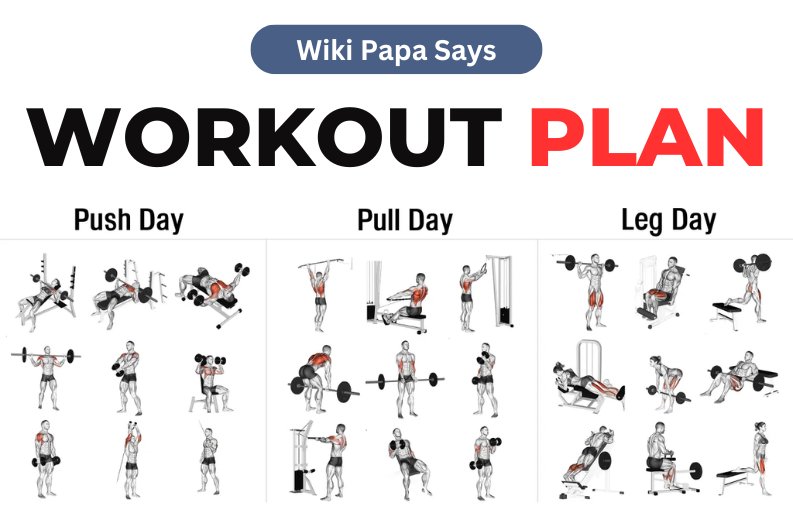A well-rounded workout plan encompasses more than just lifting weights or pounding the pavement—it incorporates a balanced combination of cardiovascular, strength, and flexibility exercises to promote overall fitness and well-being. In this article, we’ll explore the importance of incorporating cardio, strength, and flexibility into your workout plan and provide practical tips for designing a comprehensive routine that targets all aspects of fitness.
Workout Plan Components: Cardio, Strength, and Flexibility
Before we dive into the intricacies of crafting a well-rounded workout plan, let’s take a closer look at the fundamental components that comprise it—cardio, strength, and flexibility exercises. Each component plays a unique role in enhancing different aspects of fitness and overall well-being.
Cardiovascular Exercise (Cardio): Fueling Your Heart and Lungs
Cardiovascular exercise, commonly referred to as cardio, encompasses activities that elevate your heart rate and enhance cardiovascular fitness. These exercises stimulate the heart and lungs, improving their efficiency in delivering oxygen-rich blood to working muscles and removing waste products. Cardio activities range from traditional options like running, cycling, and swimming to more dynamic choices like dancing, jumping rope, or participating in aerobic classes.
Cardio workouts offer a plethora of benefits beyond cardiovascular health. They help burn calories, promote weight loss, boost mood, reduce stress, and increase endurance. Regular cardio exercise has been linked to a decreased risk of chronic diseases such as heart disease, diabetes, and certain types of cancer. Whether you prefer pounding the pavement, hitting the trails, or dancing to your favorite tunes, incorporating cardio into your workout plan is essential for overall health and fitness.
Strength Training: Building Muscle, One Rep at a Time
Strength training, also known as resistance training or weight training, involves exercises that target specific muscle groups to increase strength, power, and muscle mass. Unlike cardio, which primarily focuses on cardiovascular health, strength training emphasizes muscular development and functional strength. Strength exercises can be performed using various equipment, including free weights (e.g., dumbbells, barbells), resistance bands, weight machines, or simply your body weight.
Strength training workout plans typically consist of compound exercises that engage multiple muscle groups simultaneously, such as squats, deadlifts, bench presses, rows, and overhead presses. These exercises promote muscle hypertrophy (growth) and improve muscular strength, endurance, and functional movement patterns. Additionally, strength training helps maintain bone density, prevent age-related muscle loss (sarcopenia), and enhance metabolism by increasing lean muscle mass.
Flexibility Training: Finding Freedom in Movement
Flexibility training focuses on improving range of motion, joint mobility, and muscle flexibility through stretching, mobility exercises, and practices like yoga or Pilates. While often overlooked in favor of cardio and strength training, flexibility is a crucial component of overall fitness and functional movement. Poor flexibility can lead to stiffness, limited mobility, and increased risk of injury, particularly as we age.
Flexibility exercises aim to lengthen and stretch muscles, tendons, and ligaments, improving joint flexibility and reducing muscle tension. Static stretching, dynamic stretching, proprioceptive neuromuscular facilitation (PNF), and myofascial release techniques (foam rolling) are common methods used to enhance flexibility. Additionally, mind-body practices like yoga and Pilates incorporate movements that improve flexibility, balance, and body awareness while promoting relaxation and stress relief.
Integrating the Components: The Power of Synergy
While each component—cardio, strength, and flexibility—offers unique benefits, integrating them into a cohesive workout plan produces synergistic effects that amplify overall fitness and well-being. Cardio exercises improve cardiovascular health and endurance, strength training builds muscle strength and power, and flexibility training enhances joint mobility and prevents injury. By combining these components strategically, you create a holistic approach to fitness that addresses multiple facets of health and performance.
Importance of Balance: Benefits of a Well-Rounded Routine
Incorporating a balance of cardio, strength, and flexibility exercises into your workout plan offers numerous benefits for both physical and mental health, let’s take a recap:
- Improved Cardiovascular Health: Cardiovascular exercises strengthen the heart, improve circulation, and reduce the risk of heart disease, stroke, and other chronic conditions.
- Increased Strength and Muscle Tone: Strength training builds lean muscle mass, enhances muscular strength and endurance, and promotes functional movement patterns.
- Enhanced Flexibility and Mobility: Flexibility exercises improve joint range of motion, reduce muscle tension, and prevent injuries by enhancing flexibility and mobility.
Designing Your Workout Plan: Practical Strategies
Now, let’s explore practical strategies for incorporating cardio, strength, and flexibility into your workout plan:
Cardiovascular Exercise: Getting Your Heart Pumping
Begin each workout plan with a cardiovascular warm-up to prepare your body for exercise and gradually increase your heart rate. Incorporate cardio activities such as brisk walking, jogging, cycling, or using cardio machines like treadmills or ellipticals. Aim for at least 150 minutes of moderate-intensity cardio or 75 minutes of vigorous-intensity cardio per week, spread out over several sessions.
Strength Training: Building Strong Foundations
Include strength training exercises in your workout plan that target major muscle groups, such as squats, lunges, push-ups, rows, and overhead presses. Perform compound exercises that work multiple muscle groups simultaneously to maximize efficiency and effectiveness. Aim for at least two to three strength training sessions per week, allowing for adequate rest and recovery between workouts.
Flexibility Training: Embracing Fluidity and Ease
Incorporate flexibility exercises or yoga sessions in your workout plan to improve joint mobility, reduce muscle stiffness, and enhance overall flexibility. Focus on static stretches that target major muscle groups, holding each stretch for 15-30 seconds without bouncing. Include dynamic stretches or mobility exercises to improve movement patterns and prepare your body for activity. Aim for flexibility training sessions at least two to three times per week, ideally after your workout or on rest days.
Balancing Frequency and Intensity: Listen to Your Body
Your body is a remarkable machine, constantly providing feedback on its needs and capabilities. Learning to tune into these signals is key to crafting a workout plan that supports your goals while safeguarding your well-being. Balancing the frequency and intensity of your workouts requires a nuanced approach—one that takes into account your current fitness level, aspirations, and recovery capacity.
Personalized Adjustments: Customize Your Workout Plan
No two bodies are alike, which means there’s no one-size-fits-all approach to exercise frequency and intensity. Take the time to assess your unique circumstances, including your fitness level, exercise history, and any underlying health conditions. Use this information to tailor your workout plan to meet your individual needs and preferences.
Gradual Progression: The Path to Sustainable Growth
Progress doesn’t happen overnight—it’s a gradual journey that requires patience and perseverance. Rather than diving headfirst into intense workouts from the get-go, aim to build your fitness foundation slowly and steadily. Start with manageable frequency and intensity levels, gradually increasing them as your strength, endurance, and confidence grow.
Strategic Challenges: Pushing Your Limits Safely
Challenging your body is essential for growth and improvement, but it’s important to do so in a safe and sustainable manner. As you become more comfortable with your workouts, consider incorporating strategic challenges to push your limits. This could involve increasing the duration or intensity of your cardio sessions, lifting heavier weights during strength training, or experimenting with more advanced yoga poses.
Mindful Recovery: Nurturing Your Body’s Needs
Recovery is just as important as exercise itself—it’s during rest periods that your body repairs and strengthens itself. Incorporate rest days into your workout plan to allow your muscles time to recover and adapt to the stress of exercise. Additionally, consider implementing active recovery strategies such as gentle stretching, foam rolling, or low-intensity activities like walking or swimming to promote circulation and alleviate muscle soreness.
Listening to Signals: Honoring Your Body’s Wisdom
Above all, listen to your body’s signals and honor its wisdom. Pay attention to how you feel during and after workouts—are you energized and invigorated, or fatigued and depleted? Use this feedback to adjust your workout plan and intensity accordingly. Remember that rest is not a sign of weakness—it’s a vital component of a balanced fitness routine.
Conclusion:
Incorporating cardio, strength, and flexibility into your workout plan is essential for achieving a balanced and well-rounded fitness regimen. By including a variety of exercises that target different aspects of fitness, you can improve cardiovascular health, increase strength and muscle tone, and enhance flexibility and mobility. Experiment with different activities, find what works best for you, and enjoy the journey of improving your overall health and fitness.

